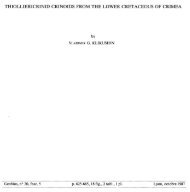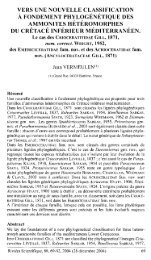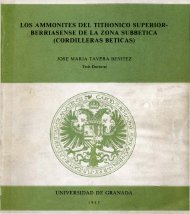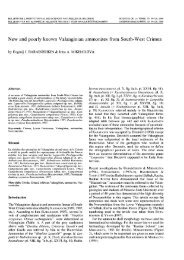peter franklin rawson, dennis curry, frank charles dilley, john michael ...
peter franklin rawson, dennis curry, frank charles dilley, john michael ...
peter franklin rawson, dennis curry, frank charles dilley, john michael ...
Create successful ePaper yourself
Turn your PDF publications into a flip-book with our unique Google optimized e-Paper software.
Unhappily the inoceramid zones in Germany have been assigned to stages bearingstandard names but with different boundaries from those used elsewhere in theworld. In order to compare the German inoceramid zonation with that of the BritishChalk, and put our zones into stages as universally used outside central Europe, it isfirst necessary to correlate the inoceramid zones with the world standard ammonitezonation. This has been done by drawing on evidence from a variety of regionswhere both ammonites and inoceramids occur together (Kauffman 1975), and byother indirect means.The international globotruncanid zonation (Table 2) is difficult to apply even tothe Aquitaine Basin because many of the zonal indices were limited to moresouthern climates. Thus Globotruncana calcarata has not been recorded north ofapproximately the front of the Alps, whilst others such as G. concavata and thesingle keeled forms of the G. stuarti group are of such rare occurrence beyondTethyan waters as to be almost valueless for correlation in northern Europe.The ConiacianThe term Coniacian was introduced by Coquand (1857) with the town of Cognac(Charente) ill the northern part of the Aquitaine Basin as the type locality. The stagein Aquitaine was described in some detail by Amaud (particularly in 1877), but wasthen largely neglected until 1956 when Seronie-Vivien started to restudy the typearea and its fauna.Base of the ConiacianThe basal glauconitic sands at Cognac, which rest unconformably on Turonianhippuritid limestones, contain no fossils of correlative value (Seronie-Vivien 1972,p. 30). However, the base of the Coniacian must coincide with the base of theSenonian, and the standard formation usually taken as the base of the Senonian isthe Craie de Villedieu of Touraine (Sornay 1957). The bottom member of thisformation (Zone A of de Grossouvre) contains ammonites which, according to deGrossouvre (1895-1901, p. 348), include: Barroisiceras haberfellneri, Peronicerastricarinaturfi, Paratexanites zeilleri, Gauthiericeras margae (sometimes quoted asUpper Coniacian), Tissotia (Metatissotia) ewaldi, Proplacenticeras fritschi, andScaphites meslei. It is this assemblage therefore that characterizes the Lower Coniacian,the Zone of Barroisiceras haberfellneri. Thus the base of the Coniacian ismarked by the appearance of Tissotia, Barroisiceras, and early texanitids such asPeroniceras.In the virtual absence of ammonites in England at these horizons, direct correlationwith the stratotype base of the Senonian is dependent on other groups, andthere is no modern work on these from the Craie de Villedieu. De Grossouvre(1895-1901) recorded Micraster decipiens from various levels in the Craie deVilledieu, and believed it a species characteristic of the Coniacian. The EnglishMicraster cortestudinarium Zone contains M. decipiens throughout (= M. cortestudinariumsensu auct. angl., ? non Goldfuss), and it is largely on this basis that inEngland the base of the Coniacian has been placed at the base of the
















